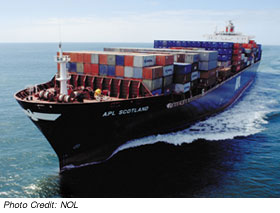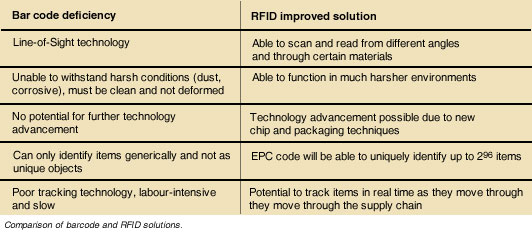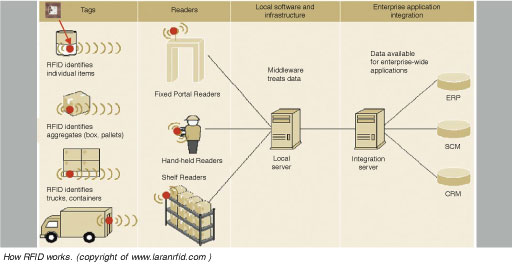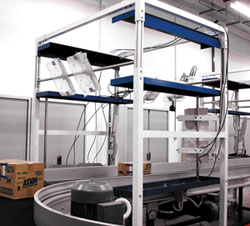|
by Lay Leng TAN and K RAGURAMAN

 eptune Orient Lines (NOL) Ltd, a major Singapore global transportation and supply-chain management company, has set up a Radio Frequency Identification (RFID) test centre in Singapore that focuses on helping companies derive supply-chain benefits from this emerging technology. Developed in partnership with Sun Microsystems, with support from Singapore's Infocomm Development Authority (IDA), the S$2.7 million NOL-Sun Advanced Technology Centre features the latest testing facilities for evaluating RFID technology and application in a "live" supply-chain environment. According to IDA, Singapore companies have committed more than S$30 million for RFID development since 2004. eptune Orient Lines (NOL) Ltd, a major Singapore global transportation and supply-chain management company, has set up a Radio Frequency Identification (RFID) test centre in Singapore that focuses on helping companies derive supply-chain benefits from this emerging technology. Developed in partnership with Sun Microsystems, with support from Singapore's Infocomm Development Authority (IDA), the S$2.7 million NOL-Sun Advanced Technology Centre features the latest testing facilities for evaluating RFID technology and application in a "live" supply-chain environment. According to IDA, Singapore companies have committed more than S$30 million for RFID development since 2004.
The centre is the first RFID facility of its kind in Southeast Asia - it provides a broad range of packaging, tag-testing, compliance-and-integration services, along with training and tag-and-ship RAGURAMANsolutions for customers. The realistic warehouse environment at the centre can simulate at each stage key segments both in the logistics process and in test-information capture and supply-chain visibility, using the latest RFID hardware and software. NOL-Sun centre offers such services as item/carton/pallet tag selection, tag/antenna placement and orientation testing, read/write reliability and interoperability testing, electronic product code (EPC)/customer-compliance testing, integration testing, solution prototyping, site surveys, tagging services, and hands-on RFID training.
RFID applies to technologies that use radio waves for automatic identification. The method most commonly used stores data that identifies a person or an object on a microchip attached to an antenna (an RFID tag). The antenna transmits the identification information to a reader, which converts the radio waves reflected back from the RFID tag into digital information passed on to computers that can make use of it.
NOL decided to work with Sun Microsystems because of the latter's expertise in RFID and information-technology systems. Sun, a pioneering member of the Auto-ID Lab initiated by the Massachusetts Institute of Technology, co-chairs the advisory committee. It actively contributes to the industry-standards organisation, EPCglobal, and participates in various working groups.
 Ken-Wei Chng, senior manager of NOL's RFID Program, Asia, notes with amused frustration that many people think of RFID as "magic dustĄ you just need to replace your barcode with RFID and all your supply-chain problems go away. RFID is just another automatic data-capture-and-identification technology like barcode and magnetic stripes. If used correctly, however, the technology can bring tremendous value to the supply chain," he clarifies. All three serve to identify data on the tagged item. Ken-Wei Chng, senior manager of NOL's RFID Program, Asia, notes with amused frustration that many people think of RFID as "magic dustĄ you just need to replace your barcode with RFID and all your supply-chain problems go away. RFID is just another automatic data-capture-and-identification technology like barcode and magnetic stripes. If used correctly, however, the technology can bring tremendous value to the supply chain," he clarifies. All three serve to identify data on the tagged item.
The main differences lie in the way the system acquires data: barcode uses optical recognition, a magnetic stripe runs on magnetic media, and RFID relies on radio frequency. RFID can capture multiple tags simultaneously; magnetic stripes and bar code can read only one tag at a time. Since RFID does not require line of sight, tags can be read from any location. With larger label and storage capacity - similar to that of the magnetic stripe - ranging from a few bytes to several hundred kilobytes, it can read/write, unlike read-only barcode. Its data-acquisition distance ranges from a few metres for a passive tag to a hundred metres for an active one. Barcodes have a few centimetres' leeway and can easily rub off or sustain damage (see comparison table).
RFID technology has existed since World War II when the British used it to track trains and boxes. The novelty lies in the way it is deployed in logistics today. RFID is not without problems, however; it does react with different products, and certain materials can compromise its effectiveness. It also costs much more than the other two.
 A typical supply chain covers how goods move from the manufacturer to a warehouse to a store and finally to the home or business. When the manufacturer produces and dispatches a product, someone must be at the dock gate to ensure it is on the right pallet, of the right quantity, and gets loaded onto the correct container. The person then has to update the warehouse management system and manually send an updated notice to the customer. Such information is usually late, affecting the backend operation and decision making. A typical supply chain covers how goods move from the manufacturer to a warehouse to a store and finally to the home or business. When the manufacturer produces and dispatches a product, someone must be at the dock gate to ensure it is on the right pallet, of the right quantity, and gets loaded onto the correct container. The person then has to update the warehouse management system and manually send an updated notice to the customer. Such information is usually late, affecting the backend operation and decision making.
An RFID reader captures the tagged goods' information when loaded onto a staging area and communicates the details immediately to the backend system. The supplier can customise the application to trigger warehouse updating, customer notification, and other related operations.
APL, NOL's logistics and container transportation subsidiary, has introduced active RFID technology to its Southern California marine terminal to speed up cargo container processing. By introducing real-time locating system technology at its Global Gateway South terminal, APL can reduce by 12 hours or more the amount of time taken to track a container in the yard and prepare it for transport.
Chng cites a number of advantages to this technology: the system frees up workers, needing one supervisor to check for exception cases or error; it provides real-time information and updates; it eliminates human error at the dispatch and at the receiving end; and it handles increased volume with no problem. High-volume suppliers and retailers such as Wal-Mart, who demand that their suppliers use RFID tagging, realise tremendous savings in time and labour. The suppliers bear the cost of the tags and infrastructure, however, whereas retailers pay only for the infrastructure.
Retail products have a global trade-identification number with 14 digits. Each product batch from a factory has the same number, and RFID allows a unique number for each item. The manufacturer can do targeted product recall if the need arises, but this apparent advantage has raised privacy issues. RFID also deters theft. Audio, video, and book stores can tag their goods to thwart shoplifters. Another application is anti-counterfeiting. Even though RFID can be copied, the database records the location of the goods to identify the genuine product.
Today, most RFID remains restricted to the United States and Europe, where three mandates exist: (1) the retailers' mandate for consumer products and the Department of Defense's mandate for its suppliers, (2) the pharmaceutical industry's mandate coming into effect in 2007 to prevent drug counterfeiting and reimportation that cut manufacturers' profits, and (3) Boeing and Airbus joint mandate that their suppliers ship parts and equipment with RFID tags.
Asia, a main manufacturing hub, is seeing more upstream supply tagging. When the demand for tagging becomes great enough, especially from big Western customers, it makes sense to tag at the source. A tag costs about US 30 cents. Add labour costs and the price doubles, but that cost disappears when tagging takes place during manufacturing.
Portals and readers along the supply chain enable acquisition of information to track cargo. Chng notes: "We are starting to see a lot of companies interested in shifting their tagging to this part of the world, but it will take another year or two before it becomes as prevalent as in the West. NOL currently works with several customers piloting such applications."
Technologies in a Container
 A cargo-tracking system involves a number of technologies. Three different tags currently exist. The Container ID Tag (also called License Plate Tag) identifies the container and replaces optical character recognition. The E-Seal provides the seal status (whether tampered with or otherwise incorrect) wirelessly. Finally, the Supply Chain Tag contains manifest information that will help information flow because it follows the physical goods instead of the traditional manifests. A cargo-tracking system involves a number of technologies. Three different tags currently exist. The Container ID Tag (also called License Plate Tag) identifies the container and replaces optical character recognition. The E-Seal provides the seal status (whether tampered with or otherwise incorrect) wirelessly. Finally, the Supply Chain Tag contains manifest information that will help information flow because it follows the physical goods instead of the traditional manifests.
A smart box housing a satellite or global system for mobile communications, together with a global-positioning system can give the location of the container. The black box, like that in an aircraft, can incorporate a reader to record conditions within the container. A refrigerated container can have temperature probes, for example, in which a reader monitors the temperature and transmits the data continuously. Light sensors (for break-in) or ammonia sensors (for stowaways) can also trigger an alarm and alert the owner remotely.
These applications remain in the pilot stage, however, as many unresolved issues abound. With multiple technologies implemented in hundreds or thousands of containers in a busy port, no one can say what will happen in the presence of communication congestion and interference.
NOL's RFID centre carries out tests to ensure the robustness of various technologies before deployment. It also conducts tours for customers to sample RFID technology and what it can do. Other services include testing RFID on different materials, simulating logistics processes to compare return on investment, and implementing the system. NOL provides training on RFID technology, application, protocol, configuration, and communication. The centre collaborates with the Alien RFID Academy, which conducts courses, as well as RFID Focus, Singapore Manufacturers' Federation, and the Logistic Institute-Asia Pacific to offer hands-on RFID instruction.
Challenges
If RFID constitutes the next great thing in the logistics industry, why then involved parties have not embraced it wholeheartedly? Cost is the main suppliers' concern. Compared to a barcode with a US 1- to 2-cent price tag, an RFID tag costs almost 30 times as much at US 30 cents. This may seem high, but if exploited to streamline operation, it can be money well spent.
The infrastructure also piles on the cost: a simple pilot system can easily cost half a million dollars. Coupled with uncertainty whether it can work, people hesitate to make the investment. Chng is convinced RFID will take off, however: "We see this as an inevitable technology since it has no other barriers except cost. But cost is seldom an issue if the technology is workable and is able to bring tangible business benefits."
Uncertainty and ignorance about the technology erect road blocks on the way to adoption. Advocates need to provide education and success stories to show that when implemented right, the system can bring the user tremendous benefit. Whether the end-to-end partners also commit to the cause poses another big challenge. If one link is broken, the value-add falls. According to Metcalfe's law for networking, the network's value is the square of the nodes; thus, value accumulates down the supply chain.
Although RFID technology has no huge critical issues, one limiting factor is powering the container for batteried tags. Not every port of call offers charging facilities. Some have proposed solar-panel or self-charging devices, but these may be damaged during rough handling of a container, not to mention the logistics of strategic panel placement required to capture sunlight. No one has satisfactorily solved this problem.
Another issue is security. US advanced manifest knows the importance of identifying who the shipper, liner, and company carrying the box are. Any unknown party or one with a poor reputation can cause the container to be searched or even denied entry to ports in the US. Total security encompasses a whole spectrum of solutions ranging from environment, personnel, policy, and access to technologies. RFID tagging technology is but one small facet of security.
NOL's RFID centre will continue to evaluate the latest developments and applications so that it can bring the best solutions to a real-world supply-chain environment.
 Click here to download the full issue for USD 6.50 Click here to download the full issue for USD 6.50
|



 eptune Orient Lines (NOL) Ltd, a major Singapore global transportation and supply-chain management company, has set up a Radio Frequency Identification (RFID) test centre in Singapore that focuses on helping companies derive supply-chain benefits from this emerging technology. Developed in partnership with Sun Microsystems, with support from Singapore's Infocomm Development Authority (IDA), the S$2.7 million NOL-Sun Advanced Technology Centre features the latest testing facilities for evaluating RFID technology and application in a "live" supply-chain environment. According to IDA, Singapore companies have committed more than S$30 million for RFID development since 2004.
eptune Orient Lines (NOL) Ltd, a major Singapore global transportation and supply-chain management company, has set up a Radio Frequency Identification (RFID) test centre in Singapore that focuses on helping companies derive supply-chain benefits from this emerging technology. Developed in partnership with Sun Microsystems, with support from Singapore's Infocomm Development Authority (IDA), the S$2.7 million NOL-Sun Advanced Technology Centre features the latest testing facilities for evaluating RFID technology and application in a "live" supply-chain environment. According to IDA, Singapore companies have committed more than S$30 million for RFID development since 2004.
 Ken-Wei Chng, senior manager of NOL's RFID Program, Asia, notes with amused frustration that many people think of RFID as "magic dustĄ you just need to replace your barcode with RFID and all your supply-chain problems go away. RFID is just another automatic data-capture-and-identification technology like barcode and magnetic stripes. If used correctly, however, the technology can bring tremendous value to the supply chain," he clarifies. All three serve to identify data on the tagged item.
Ken-Wei Chng, senior manager of NOL's RFID Program, Asia, notes with amused frustration that many people think of RFID as "magic dustĄ you just need to replace your barcode with RFID and all your supply-chain problems go away. RFID is just another automatic data-capture-and-identification technology like barcode and magnetic stripes. If used correctly, however, the technology can bring tremendous value to the supply chain," he clarifies. All three serve to identify data on the tagged item.
 A typical supply chain covers how goods move from the manufacturer to a warehouse to a store and finally to the home or business. When the manufacturer produces and dispatches a product, someone must be at the dock gate to ensure it is on the right pallet, of the right quantity, and gets loaded onto the correct container. The person then has to update the warehouse management system and manually send an updated notice to the customer. Such information is usually late, affecting the backend operation and decision making.
A typical supply chain covers how goods move from the manufacturer to a warehouse to a store and finally to the home or business. When the manufacturer produces and dispatches a product, someone must be at the dock gate to ensure it is on the right pallet, of the right quantity, and gets loaded onto the correct container. The person then has to update the warehouse management system and manually send an updated notice to the customer. Such information is usually late, affecting the backend operation and decision making.
 A cargo-tracking system involves a number of technologies. Three different tags currently exist. The Container ID Tag (also called License Plate Tag) identifies the container and replaces optical character recognition. The E-Seal provides the seal status (whether tampered with or otherwise incorrect) wirelessly. Finally, the Supply Chain Tag contains manifest information that will help information flow because it follows the physical goods instead of the traditional manifests.
A cargo-tracking system involves a number of technologies. Three different tags currently exist. The Container ID Tag (also called License Plate Tag) identifies the container and replaces optical character recognition. The E-Seal provides the seal status (whether tampered with or otherwise incorrect) wirelessly. Finally, the Supply Chain Tag contains manifest information that will help information flow because it follows the physical goods instead of the traditional manifests.
 Click here to download the full issue for USD 6.50
Click here to download the full issue for USD 6.50